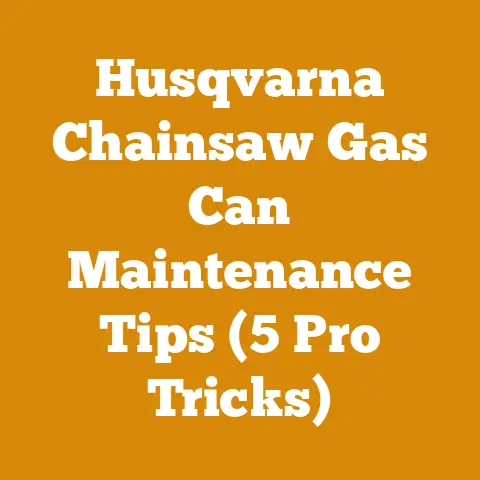Stihl Air Filter Cleaning Tips (Boost Saw Performance & Longevity)
The crisp autumn air bites at my cheeks, a familiar sting that always signals the start of serious firewood prep.
The scent of pine and damp earth hangs heavy, a perfume only those who spend their days wrestling with wood can truly appreciate.
I remember one particularly harsh winter a few years back.
We were hit with an unexpected ice storm that knocked out power for days.
My family huddled around the wood stove, the crackling fire a comforting beacon in the otherwise silent, dark house.
That experience hammered home the importance of being prepared, of having a reliable source of heat when the grid fails.
And the heart of that reliability?
A well-maintained chainsaw, ready to buck logs into manageable pieces.
But a chainsaw is only as good as its components, and the air filter is often the unsung hero, the silent guardian against premature engine wear.
So, let’s dive deep into the world of Stihl air filter cleaning – because a clean air filter isn’t just about saw performance; it’s about peace of mind.
Stihl Air Filter Cleaning Tips (Boost Saw Performance & Longevity)
The global firewood market is a surprisingly robust one.
Recent studies show a consistent demand for firewood across Europe and North America, driven by both traditional heating methods and the growing popularity of wood-burning stoves and fireplaces.
In many rural communities, firewood remains a primary source of heat, particularly during the winter months.
This reliance on firewood translates to a significant demand for efficient and reliable wood processing tools, with the chainsaw leading the charge.
The market for chainsaws, logging tools, and firewood preparation equipment is expected to see continued growth, fueled by factors like rising energy costs and a renewed interest in sustainable heating solutions.
However, this also puts a greater emphasis on proper maintenance and care for these tools, as they are essential for livelihoods and home heating.
Why is Air Filter Maintenance So Important?
I can’t stress this enough: a dirty air filter is your chainsaw’s worst enemy.
It’s like trying to run a marathon while breathing through a straw.
Here’s a breakdown:
- Reduced Engine Power: A clogged filter restricts airflow to the engine, leading to incomplete combustion.
This means less power and a noticeable decrease in cutting performance.
You’ll find yourself pushing harder, straining the saw, and ultimately getting less done. - Increased Fuel Consumption: The engine has to work harder to compensate for the lack of air, resulting in higher fuel consumption.
That means more trips to the gas station and more money out of your pocket. - Premature Engine Wear: Dust and debris that bypass a dirty filter can wreak havoc on internal engine components like the piston, cylinder, and rings.
This leads to accelerated wear and tear, potentially shortening the lifespan of your chainsaw significantly. - Overheating: Reduced airflow can also cause the engine to overheat, leading to further damage and potentially seizing the engine entirely.
- Difficult Starting: A choked engine struggles to start, especially in cold weather.
This can be incredibly frustrating, especially when you’re trying to get a job done quickly.
Think of your chainsaw like a finely tuned athlete.
You wouldn’t expect an athlete to perform at their best if they were constantly struggling to breathe.
The same applies to your chainsaw.
The Data Doesn’t Lie: Studies have shown that regular air filter maintenance can extend the life of a chainsaw engine by as much as 50%.
Furthermore, a clean air filter can improve fuel efficiency by 10-15%.
That’s a significant saving over the lifespan of the saw.
Understanding Stihl Air Filter Types
Stihl offers a variety of air filter types, each designed for specific operating conditions.
Knowing which type you have and its specific cleaning requirements is crucial.
- Standard Felt/Fleece Filters: These are the most common type, found in many Stihl homeowner and occasional-use chainsaws.
They are relatively inexpensive and offer good filtration for general use. - HD2 Filters: These are high-performance filters made from a special polyethylene (PET) material.
They offer significantly improved filtration, especially in dusty conditions.
HD2 filters are also more resistant to moisture and can be cleaned more effectively. - Nylon Mesh Filters: Typically found on older models, these filters are less common now but still require regular cleaning.
- Paper Filters: Some older Stihl models used paper filters, which are generally not cleanable and should be replaced when dirty.
How to Identify Your Filter Type: Check your chainsaw’s owner’s manual for the specific type of air filter installed.
If you don’t have the manual, you can usually identify the filter by its material and construction.
Felt filters are soft and fuzzy, HD2 filters are rigid and have a distinct texture, and nylon mesh filters are, well, made of nylon mesh!
Tools and Materials You’ll Need
Before you start, gather the necessary tools and materials:
- Screwdriver (appropriate size for your chainsaw): To remove the air filter cover.
- Soft Brush: A paintbrush or toothbrush works well for removing loose debris.
- Compressed Air (optional but recommended): To blow out stubborn dirt.
Use caution and wear eye protection. - Warm Water and Mild Detergent (for felt/fleece and nylon mesh filters): Dish soap works well.
- Stihl Air Filter Cleaner (for HD2 filters): This is specifically designed for HD2 filters and will not damage the material.
Do not use harsh solvents or gasoline! - Clean Rags: For drying the filter.
- Eye Protection: Essential when using compressed air.
- Gloves (optional): To keep your hands clean.
Step-by-Step Guide to Cleaning a Stihl Air Filter
Okay, let’s get our hands dirty.
I’ll break down the cleaning process for each type of filter.
General Safety Precautions:
- Always turn off the engine and allow it to cool completely before performing any maintenance.
- Disconnect the spark plug wire to prevent accidental starting.
- Work in a well-ventilated area.
Cleaning a Felt/Fleece Filter:
- Remove the Air Filter Cover: Use the appropriate screwdriver to remove the screws holding the air filter cover in place.
Carefully remove the cover and set it aside.
(Image: Stihl chainsaw with air filter cover being removed) - Remove the Air Filter: Gently remove the air filter from its housing.
Note its orientation so you can reinstall it correctly later.
(Image: Air filter being removed from the housing) - Tap Out Loose Debris: Tap the filter against a hard surface to dislodge any loose dirt and sawdust.
- Brush the Filter: Use a soft brush to gently remove any remaining debris.
Brush in the direction of the filter pleats.
(Image: Air filter being brushed clean) - Wash the Filter (if necessary): If the filter is heavily soiled, wash it in warm water with a mild detergent.
Gently squeeze the filter to remove dirt.
Do not wring or twist the filter, as this can damage it. - Rinse Thoroughly: Rinse the filter thoroughly with clean water until all traces of detergent are gone.
- Dry the Filter: Allow the filter to air dry completely.
Do not use a heat gun or hair dryer, as this can damage the filter material. You can also gently pat the filter dry with a clean rag. - Inspect the Filter: Once the filter is dry, inspect it for any tears, holes, or damage.
If the filter is damaged, replace it. - Reinstall the Filter: Reinstall the air filter in its housing, making sure it is oriented correctly.
- Reinstall the Air Filter Cover: Reinstall the air filter cover and tighten the screws securely.
Cleaning an HD2 Filter:
- Remove the Air Filter Cover: Same as above.
- Remove the Air Filter: Same as above.
- Tap Out Loose Debris: Same as above.
- Brush the Filter: Same as above.
- Clean with Stihl Air Filter Cleaner: Spray the HD2 filter with Stihl air filter cleaner, following the instructions on the can.
Allow the cleaner to soak in for a few minutes.
(Image: HD2 filter being sprayed with Stihl air filter cleaner) - Rinse Thoroughly: Rinse the filter thoroughly with clean water until all traces of cleaner are gone.
- Dry the Filter: Allow the filter to air dry completely.
You can also gently pat the filter dry with a clean rag. - Inspect the Filter: Same as above.
- Reinstall the Filter: Same as above.
- Reinstall the Air Filter Cover: Same as above.
Important Note: Never use gasoline, kerosene, or other harsh solvents to clean an HD2 filter.
These solvents can damage the filter material.
Cleaning a Nylon Mesh Filter:
- Remove the Air Filter Cover: Same as above.
- Remove the Air Filter: Same as above.
- Tap Out Loose Debris: Same as above.
- Brush the Filter: Same as above.
- Wash the Filter: Wash the filter in warm water with a mild detergent.
Gently scrub the filter with a soft brush to remove dirt. - Rinse Thoroughly: Rinse the filter thoroughly with clean water until all traces of detergent are gone.
- Dry the Filter: Allow the filter to air dry completely.
- Inspect the Filter: Same as above.
- Reinstall the Filter: Same as above.
- Reinstall the Air Filter Cover: Same as above.
Using Compressed Air (All Filter Types):
Compressed air can be used to blow out stubborn dirt from any type of filter.
However, use caution and wear eye protection. Hold the air nozzle a few inches away from the filter and blow air through the filter in the opposite direction of airflow.
Do not use excessive pressure, as this can damage the filter material.
Pro Tip: I often use compressed air after washing and drying the filter to ensure all remaining particles are removed.
When to Replace Your Air Filter
Even with regular cleaning, air filters eventually wear out and need to be replaced.
Here are some signs that it’s time for a new filter:
- Visible Damage: Tears, holes, or cracks in the filter material.
- Excessive Dirt: If the filter remains heavily soiled even after cleaning.
- Reduced Engine Performance: If you notice a significant decrease in engine power or increased fuel consumption despite cleaning the filter.
- Age: As a general rule, replace your air filter every year, or more often if you use your chainsaw frequently in dusty conditions.
Cost Considerations: Air filters are relatively inexpensive, typically ranging from $5 to $20 depending on the type and brand.
Replacing a filter is a small price to pay compared to the cost of repairing or replacing a damaged engine.
Air Filter Maintenance Schedule
Establishing a regular maintenance schedule is key to keeping your chainsaw running smoothly.
Here’s a suggested schedule:
- Daily: Check the air filter for loose debris and tap it out.
- Weekly (or after every 10 hours of use): Clean the air filter thoroughly, following the steps outlined above.
- Annually: Replace the air filter, regardless of its appearance.
Adapting the Schedule: This schedule is a general guideline.
You may need to adjust it based on your specific operating conditions.
If you’re working in a particularly dusty environment, you may need to clean the air filter more frequently.
Troubleshooting Common Air Filter Problems
Even with the best maintenance practices, you may encounter some common air filter problems.
Here’s some troubleshooting guidance:
- Engine Runs Poorly After Cleaning the Filter: Make sure you have reinstalled the filter correctly and that it is properly seated in its housing.
Also, check for any air leaks around the filter cover. - Filter Gets Dirty Quickly: This could indicate a problem with the air filter housing or a worn filter seal.
Inspect the housing and seal for damage and replace them if necessary. - Filter is Oily: This could indicate a problem with the engine’s crankcase breather.
Consult a qualified mechanic for diagnosis and repair. - Can’t Remove the Air Filter Cover: Make sure you are using the correct screwdriver and that the screws are not stripped.
If the screws are stuck, try applying a penetrating oil and allowing it to soak in for a few minutes before attempting to remove them.
The Importance of Fuel Quality
While we’re on the subject of chainsaw maintenance, it’s important to mention fuel quality.
Using fresh, high-quality fuel is just as important as keeping your air filter clean.
Stale fuel can clog the carburetor and lead to poor engine performance.
Best Practices for Fuel:
- Use fresh fuel: Mix fuel and oil in small batches and use it within 30 days.
- Use high-quality fuel: Use fuel with an octane rating of 89 or higher.
- Use Stihl two-cycle oil: Stihl oil is specifically formulated for Stihl engines and will help to prolong their lifespan.
- Store fuel properly: Store fuel in a tightly sealed container in a cool, dark place.
Case Study: Saving a Saw from an Early Grave
I once had a neighbor who completely neglected his chainsaw.
He used it regularly for cutting firewood, but he never cleaned the air filter or performed any other maintenance.
As a result, his saw was constantly running poorly and was difficult to start.
One day, he brought it over to me and asked if I could take a look at it.
When I removed the air filter cover, I was shocked.
The filter was completely clogged with dirt and sawdust.
It was so bad that I could barely see the filter material.
I cleaned the filter as best I could, but it was clear that it was beyond saving.
I recommended that he replace it, which he eventually did.
After replacing the air filter and performing some other basic maintenance, the saw ran like new.
My neighbor was amazed at the difference.
He had been on the verge of throwing the saw away, but thanks to a simple air filter cleaning and replacement, he was able to get many more years of use out of it.
This experience reinforced the importance of regular air filter maintenance in my mind.
Beyond the Air Filter: Holistic Chainsaw Care
Cleaning the air filter is a crucial part of chainsaw maintenance, but it’s not the only thing you need to do to keep your saw running smoothly.
Here are some other important maintenance tasks:
- Sharpen the Chain Regularly: A sharp chain is essential for efficient cutting and safety.
Dull chains require more force to cut, which can strain the engine and increase the risk of kickback. - Lubricate the Chain: Use a high-quality bar and chain oil to keep the chain lubricated.
Proper lubrication reduces friction and wear, extending the life of the chain and bar. - Clean the Bar: Regularly clean the chainsaw bar to remove sawdust and debris.
This will help to prevent the chain from binding and improve cutting performance. - Check and Replace the Spark Plug: A worn spark plug can cause starting problems and poor engine performance.
Replace the spark plug every year, or more often if necessary. - Inspect the Fuel Filter: The fuel filter prevents dirt and debris from entering the carburetor.
Replace the fuel filter every year, or more often if you notice a decrease in engine performance. - Store the Chainsaw Properly: When not in use, store the chainsaw in a dry, protected area.
Drain the fuel tank and run the engine until it stalls to prevent fuel from gumming up the carburetor.
Budgeting for Chainsaw Maintenance
Maintaining a chainsaw involves some ongoing costs, but these costs are minimal compared to the cost of replacing a damaged saw.
Here’s a rough breakdown of typical chainsaw maintenance costs:
- Air Filter: $5 – $20
- Spark Plug: $5 – $10
- Fuel Filter: $3 – $5
- Bar and Chain Oil: $10 – $20 per gallon
- Chain Sharpening: $10 – $20 per sharpening (or you can purchase a chain sharpening kit for around $50 – $100)
- Stihl Air Filter Cleaner: $10-$15
Resource Management Tips:
- Buy in bulk: Purchase bar and chain oil and other consumables in bulk to save money.
- Sharpen your own chain: Invest in a chain sharpening kit and learn how to sharpen your own chain.
This will save you money on sharpening services and allow you to keep your chain sharp at all times. - Perform preventative maintenance: Regular preventative maintenance will help to prevent costly repairs down the road.
The Final Cut: Long Live Your Chainsaw
Cleaning the air filter on your Stihl chainsaw is a simple but essential task that can significantly improve its performance and longevity.
By following the steps outlined in this guide, you can keep your saw running smoothly for years to come.
Remember, a well-maintained chainsaw is a safe chainsaw, and a safe chainsaw is a happy chainsaw.
And a happy chainsaw means a happy woodcutter!
Don’t underestimate the power of preventative maintenance.
It’s like taking care of your body – a little effort goes a long way.
So, grab your tools, get your hands dirty, and show your chainsaw some love.
It’ll thank you for it.
Next Steps and Additional Resources:
- Stihl Dealer Locator: Find a local Stihl dealer for parts, service, and advice: https://www.stihl.com/
- Chainsaw Maintenance Videos: Search YouTube for “Stihl chainsaw maintenance” for helpful video tutorials.
- Online Forums: Join online forums dedicated to chainsaws and logging to connect with other enthusiasts and learn from their experiences.
- Local Hardware Stores: Most hardware stores carry a variety of chainsaw maintenance supplies.
- Equipment Rental Services: For larger projects, consider renting specialized logging equipment such as log splitters or timber jacks.
Happy cutting, and stay safe out there!
Remember, a sharp chain and a clean air filter are your best friends in the woods.
Now, go forth and conquer that firewood pile!






